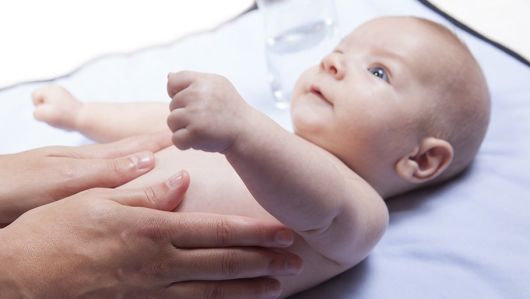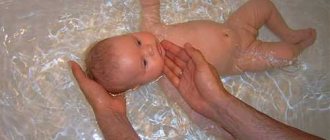One of the most common causes of crying in a newborn baby during the first three months of life is intestinal colic. The main factors causing their occurrence are the immaturity of the baby’s digestive system and a violation of the diet by the nursing mother. A lot depends on nutrition during breastfeeding, so every woman must know which foods can increase gas formation in newborns.
Causes of gas leaks in infants
The occurrence of increased gas formation or flatulence is a consequence of insufficient production of gastric juice, as well as the general immaturity of the infant’s digestive organs.
This, in turn, leads to the fact that the breast milk that has already entered the stomach will not be completely digested until the next meal. Undigested milk undergoes a fermentation process, which contributes to the appearance of gases that stretch the intestinal walls and provoke pain.
Also, increased gas production in a newborn may occur for the following reasons:
- Unbalanced diet of a nursing mother. In particular, increased gas formation in a child is caused by the mother’s consumption of the following products: Cow’s milk (you can use kefir, it does not have a similar effect);
- Carbonated water (including mineral water);
- Certain vegetables and fruits (legumes, cabbage, apples, grapes, etc.);
- Bakery products;
- Sweet dishes containing refined sugar;
Unwanted Products
There is a direct connection between nutrition and the quality of breast milk. And if a woman on breastfeeding eats anything that promotes gas formation, then the baby suffers from intestinal colic. Therefore, during breastfeeding, especially the first 3 months, a woman is contraindicated to eat certain types of food.
Foods that cause bloating in a baby:
Black bread
This product is obtained by fermentation, so it is better to exclude it from the diet during breastfeeding. Black bread can be replaced with whole grain bread, which has a good effect on digestion, improves metabolism and enriches the body with vitamins. For the mother of a baby, the best option would be bread with cumin. Their components have a good effect on the lactation process and have a carminative effect.
Milk
The product is not recommended during breastfeeding for two reasons: it can not only provoke allergies in infants, but also contribute to the appearance of intestinal colic.
The consumption of boiled whole milk is not recommended during the first months of breastfeeding; it should not even be added to cereals. You can pour a small amount of milk into tea.
Products such as kefir, yogurt, cheese and cottage cheese are suitable as milk substitutes. Better tolerance of goat's milk has been noted compared to cow's milk, but not everyone likes it because of its specific taste and smell.
Legumes
All legumes have a high gas-forming effect on the intestines. Products such as beans, chickpeas, lentils, peas and soy are in first place in terms of vegetable protein content, but at the same time provoke increased flatulence.
Vegetables and fruits
Raw plant foods take a long time and are difficult to digest and cause fermentation. In addition, it can promote infection by microorganisms, so vegetables and fruits should be eaten after heat treatment. In this case, the process of breaking down food is accelerated and the risk of infection is eliminated.
Plant foods are very useful for breastfeeding because they contain trace elements and vitamins. Within 14 days after birth, zucchini, carrots, potatoes, pumpkin, apples and bananas are introduced into the diet.
You should hold off on exotic fruits, as they contribute to allergies.
During breastfeeding, you should not eat white cabbage and beets, since these are difficult-to-digest vegetables that cause flatulence and colic.
It is better to steam vegetable products; they can also be stewed, boiled and baked.
Confectionery and baked goods
Sweets can also contribute to colic in babies. Mothers with breastfeeding should not eat flour products with cream filling, cream, chocolate, or baked goods. Dried fruits, marshmallows, biscuits and oatmeal cookies, marshmallows, jam and marmalade are allowed in small quantities.
Symptoms of gas in infants
Experienced and trained parents are able to determine by the child’s crying what is bothering the child: gas, hunger or fear. However, such parents do not always admit that a sharp cry and crying of a child can provoke not only gas and colic, but also, for example, an infectious disease, meningitis, volvulus and other serious diseases.
Therefore, we recommend that at the first concern of the child, seek advice from a pediatrician and record all the symptoms that can confirm or refute the cause-and-effect relationship between the child’s crying and the presence of increased gas production.
Symptoms of gasses include:
- Attacks of crying occurring at the same time;
- Hard belly;
- The child presses his hands to his body;
- Arching;
- Tucking up the legs;
- The child often strains and blushes;
- The baby experiences relief after bowel movements and/or passing gas.
Moreover, in the intervals between these attacks, the child behaves quite normally. He is calm, has normal temperature, appetite and even weight gain.
If, in your case, the child has additional symptoms, namely fever, rashes on the body, prolonged vomiting containing mucus, weakness or diarrhea with foam, immediately consult a doctor, as these symptoms may indicate the presence of a much more serious problem. serious illness.
Reasons why gas occurs in newborns
There is probably no child in the world who has not had a tummy ache at least once before the age of three months. The reason for this is the immaturity of the digestive system and liver, as well as weak fermentation of gastric juice, as a result of which all food entering the stomach is not able to be digested until the next meal. This causes fermentation and the formation of gases, which, stretching the walls of the stomach and small intestine, cause pain in the baby.
In addition to weak fermentation, which occurs in 70% of babies of this age, important factors influencing the process of colic occurrence are the following:
- Swallowing of air by a child due to improper attachment to the breast. When artificial feeding, it is also necessary to choose a bottle that ensures minimal swallowing of air thanks to a special anatomical nipple shaped like a female nipple.
- Improper organization of feeding and overfeeding the baby contribute to the occurrence of gas. If applied too frequently, the food does not have time to be digested. You need to feed with a minimum break of 2 hours , trying to increase the interval to 3 hours.
- Baby overheating. Excessive care and fear of catching a cold in a newborn, wrapping him in blankets and rugs, leads to a slowdown in metabolism and digestion processes and the development of microflora that contributes to gas formation in the stomach and intestines.
- Non-compliance with the mother's diet while breastfeeding. All products consumed by a woman are passed on to the baby through breast milk. During this period, you should follow a special diet that excludes carbonated drinks, smoked foods, chocolate, alcohol, fatty and spicy foods, garlic, legumes, plums, grapes, cabbage and much more that can cause abdominal pain in a child after breastfeeding.
Reading...
What should be in a first aid kit for newborns
Less common reasons, which, however, should not be discarded include:
- Prematurity.
- Heavy emotional atmosphere in the family.
- Maternal smoking during pregnancy and lactation.
- Poor digestibility of lactose.
- Inappropriate mixture.
- Mixture too thick.
- Formula feeding after breastfeeding.
- Poorly developed abdominal muscles.

Colic and gas: what's the difference?
It should be understood that colic and gas are different problems, although they belong to the same complex, called functional disorders of the gastrointestinal tract of the infant.
Increased gas production in the intestines is also known as flatulence. Its appearance is provoked by the physiological immaturity of the child’s digestive organs and nervous system, intestinal dysbiosis, unformed metabolism, insufficient amounts of enzymes produced, as well as their activity.
In most cases, increased gas formation in infants goes away by 3 months.
Colic is a painful sensation of a spastic nature. They are a consequence of flatulence. They arise due to tension in the intestinal walls. If the gases are eliminated in a timely manner, colic may not occur at all.
Colic in newborns. You can find out what to treat in our article. When a child begins to sleep through the night, read here.
Read about mixed feeding of a newborn at the link
Application of gas outlet tube
You can urgently help your baby relieve pain using a gas tube. Installation of this device is an extreme measure and should be used only in rare cases - Dr. Komarovsky speaks about this.
You can install the gas outlet pipe as follows:
Tips for parents: Always check whether this action is effective. You can understand this by the behavior of the baby. The baby, who is screaming and crying, clearly does not receive relief from the procedure. Do not install the gas outlet tube frequently. The body must learn to remove gases on its own, and there is also a danger of causing injury to the mucous membrane.
How to help your baby with increased gas production? The presence of severe symptoms (crying, screaming, twitching of legs) implies the possibility of taking medications. Antispasmodics and carminatives will have an analgesic effect. Less pronounced symptoms can be relieved in gentle ways: massage, gymnastics, herbal infusions, laying on the tummy, adjusting the feeding mother’s diet and proper feeding technique.

Gas leaks in newborns while breastfeeding are a common problem. Due to the immaturity of the digestive system, a large amount of air accumulates in the cavity of the gastrointestinal tract, which subsequently brings severe discomfort to the baby. The parents’ desire to quickly help the baby is natural - he cries, sleeps and eats poorly, groans and suffers from constipation. What can be done to rid a breastfed baby of gas, why the problem is so common, and how to distinguish simple flatulence from a serious illness is described below.
How to prevent gas in newborns
First, you need to establish the reason for the formation of gases and try to eliminate all factors that can provoke flatulence (if these factors are not anatomical and physiological characteristics of the baby’s body).
There are several recommendations that will help reduce the likelihood of pain:
- Foods should be introduced into the diet gradually, adhering to a certain order. Products that can cause increased gas formation should either be eliminated or consumption should be reduced to a minimum;
- Before eating, place the newborn on his stomach and do gymnastics for him, consisting of light physical exercises;
- After each meal, the baby needs to be held in an upright position for some time. This will help remove excess air that may have entered during feeding;
- Breastfeeding your baby should be done with extreme caution. The main rule is not to overfeed. Even breast milk in excessive quantities can be harmful;
- Also, you should not overheat the baby by wrapping him in several diapers at once;
- Stick to the established daily routine;
- If a child loves water treatments, give him warm baths regularly.
How to help a child with gas in the stomach?
Gases are a common occurrence in breastfed newborns, but if they greatly bother the baby, what should you do? The main thing is to identify the cause of the problem and eliminate it. If gas leaks are caused by errors in the mother’s diet, you need to choose the right diet; for dysbacteriosis and lactase deficiency, drug treatment is necessary. Next, we will describe ways to combat gas in breast-fed babies, available to every mother.
Grandmothers advised carrying the baby in a column, placing it with its tummy against their belly. The baby should remain in this position until he burps the air obtained during feeding. You can talk to the baby, move around the room, speeding up the process of emptying the stomach of excess gases.
To help a child with gas in the stomach, mothers use a relaxing technique such as massage. You should not start massaging immediately after eating, at least half an hour should pass, or you should do this if you have the symptoms of anxiety described above. The technique includes several movements:
You can also help your baby get rid of the gases with massage and gymnastics. You need to place him on the fitball with his stomach and make light springy movements, supporting him and preventing injuries. If the throttles are bothering your baby right now, you should not do exercises on the ball, this will only increase the discomfort.
In ancient times, when mothers during breastfeeding did not know how to rid the baby of gas, they applied a warm diaper or heating pad to the tummy. It is known that the baby should not be overheated, but when heat is applied locally, it has a beneficial effect on the condition of the abdomen. After some time, the baby will calm down, the intestines will relax, and the gas will pass freely.
On a note! You can prepare warm baths for your baby with the addition of medicinal herbs - it could be chamomile, calendula, sage, or you can simply use sea salt. It is not necessary to add anything to the water, the main thing is that the heat helps relax the muscles, and the baby enjoys the water procedure.
It has been known for decades that dill seed tincture is a reliable and affordable remedy if a breastfed baby is suffering from gas. This composition helps to cope with pain, cramps, and facilitate the release of gas accumulation from the intestines. To prepare the decoction, take a teaspoon of raw material and pour 100 ml of boiling water, then infuse and cool. You can purchase a ready-made dill-based remedy at the pharmacy if you don’t want to make it yourself.
To stop breastfed babies from being tormented by gas, they give a warm enema - it also helps with constipation, which often accompanies flatulence. You need to buy the smallest enema for newborns, boil it before use and remove the air. The baby is laid on its side, the tip of the syringe is lubricated with Vaseline and injected to a depth of 2-3 cm.
Warm water should be introduced into the intestines gradually, and then squeeze the baby’s buttocks so that the liquid does not come out prematurely. This measure is considered an emergency if flatulence or constipation occurs during breastfeeding. But you should not use an enema regularly, otherwise the intestines will wean themselves from functioning independently, without outside stimulation.
In order not to injure the delicate intestinal mucosa of the baby, it is often impossible to install a gas outlet tube during increased flatulence. But in case of an urgent need to eliminate gas leaks, if the baby is crying and kicking his legs, such a device will come in handy. It should be used in the same way as an enema, but inserted into the intestines to a depth of 5 cm, no more. The tube will not be inserted beyond the specified depth thanks to the limiter, and the process must be carried out with screwing movements. After the gases have gone away, the gas outlet must be rinsed thoroughly and make sure that the procedure helped the baby.
Gas in a newborn: how to help
There are 10 different ways to help your child with flatulence. Each of them has already passed the test of time and proven its effectiveness. Of course, some of them will suit your child more, and some less. All you have to do is choose the best one.
Method 1. Massage
Take your baby in your arms and press your belly to your body. After this, lay him on his back, warm up his palms and give the child a light relaxing massage. To distract your child from the sensations, talk to him gently throughout the procedure.
Method 2. Gymnastic exercise “Bicycle”
Lay the baby on his back, then alternately bend and unbend his legs, lifting each of them towards his stomach. These movements will provoke the rapid release of gases.
Method 3. Carrying on your hands
There are two ways to carry a baby in your arms. The first is to carry the baby upright, with his legs tucked under him and held close to you. The second is horizontal, placing the child with his stomach on his bent arm.
Method 4. Laying on the stomach
This method is very important in terms of preventing flatulence. In addition, it contributes to the normal physical development of the child. The baby should be regularly placed on his stomach from the first days of his life.
It is recommended to do this before feeding to eliminate the possibility of regurgitation. However, if attacks of colic have already begun, laying out should be abandoned for a while, as it will only cause additional discomfort.
Method 5. Vertical position after feeding
After the child has eaten, he should be kept in an upright position for about 10 minutes. If the baby swallows air along with food while standing, he will definitely belch out all the excess air.
Method 6. Fitball
Experts advise placing the child with his stomach on a large ball and, holding it, make springing movements. As in the case of laying on the stomach, exercises with a fitball should only be done in the absence of colic and gas.
Method 7. Dill water
This product is a tincture of dill seeds. It is very popular not only because of its effectiveness, but also because of its low cost. The product is able to relieve spasms, prevent increased gas formation and remove gases from the intestines.
The baby constantly cries and does not sleep. You can find out what to do in our article. How to bathe a newborn baby, read here.
How to massage a child, read the link
This remedy can either be bought at a pharmacy or prepared yourself (by mixing a teaspoon of dill seeds and half a glass of boiling water).
An alternative to dill tea can be fennel tea, chamomile decoction, as well as drugs such as espumisan, babynos, sub simplex and babycalm.
Causes
In 70% of cases of flatulence in newborns, doctors are inclined to believe that the cause is associated with weak fermentation . The liver and digestive system are not yet quite ready for full loads and are adapting to a new type of nutrition. The secretion of gastric juice is still weak, so food is not completely digested. As a result, fermentation processes begin, which stretch the walls of the small intestine and provoke unpleasant sensations.
In addition, gases in the intestines may be a result of swallowing air . This can happen with both breastfeeding and bottle-feeding. Therefore, when artificial feeding, an anatomical, that is, close to natural forms, nipple is required, which prevents the baby from swallowing air along with food. It should have a hole of the right size so that the baby does not choke on the mixture and does not work too hard to get food. In addition, manufacturers make an additional hole at the base of the nipple, thanks to which it does not stick together during feeding.
The mixture itself can also cause gas formation, because its composition only loosely resembles breast milk. You may have to try different mixtures before finding one that doesn't cause discomfort. Remember that the situation can be affected by violation of the rules for storing and preparing the formula, as well as the adjusted interval between feedings. The concentration must strictly correspond to the recipe and age, the required liquid temperature is 36-37 ° C. If the baby has not finished eating, the leftovers are always thrown away, as this is a favorable environment for the growth of bacteria.











